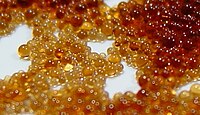
Photo from wikipedia
Abstract Herein, an amino-modified electrospun nanofibrous cellulose membrane (CA-PVAm) was prepared and employed to adsorb the typical organoarsenic contaminants (roxarsone (ROX), p-arsanilic acid (p-ASA), and phenylarsonic acid (PAA)). The SEM,… Click to show full abstract
Abstract Herein, an amino-modified electrospun nanofibrous cellulose membrane (CA-PVAm) was prepared and employed to adsorb the typical organoarsenic contaminants (roxarsone (ROX), p-arsanilic acid (p-ASA), and phenylarsonic acid (PAA)). The SEM, FT-IR, and XPS results showed that the CA-PVAm composed of abundant nanofibres and owned ample functional groups such as NH2, OH, and C O groups. The batch experiments demonstrated that the CA-PVAm exhibited excellent adsorption performance on ROX (186.22 mg g−1), p-ASA (69.15 mg g−1), and PAA (62.77 mg g−1), which were 15.98, 6.83, and 6.25 folds larger than those of the pristine CA. In addition, the adsorption process of ROX, p-ASA, and PAA on CA-PVAm accorded with the Langmuir model and obeyed the pseudo-second-order model with intraparticle diffusion. Meanwhile, the adsorption of ROX and PAA was endothermic process, but the exothermic process was observed during the p-ASA adsorption. Furthermore, the main adsorption mechanisms involved electrostatic interactions and hydrogen-bonding interactions. The formed stable six-membered structure between NH2 and NO2 groups could significantly enhance the hydrogen-bonding interactions between CA-PVAm and ROX molecule, resulting in evident improvement in ROX adsorption. Importantly, the CA-PVAm displayed outstanding reusability (4 cycles) and rapid desorption rate. This study probably provides an important theoretical and experimental basis for the remediation of the emerging organic pollutants.
Journal Title: Chemical Engineering Journal
Year Published: 2020
Link to full text (if available)
Share on Social Media: Sign Up to like & get
recommendations!